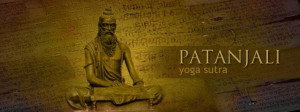
Patanjali
Patanjali is the author of Yoga Sutra, yoga reference text. Yoga is one of six Darshana of Hindu philosophical system.
The text we are referring here in four chapter describes what yoga is, his processing, his powers and his release. We invite you to study this text with a qualified teacher.
Here is the system described in the Sutra of Patanjali:
ASHTANGA
The term Ashtanga Yoga derives from the Sanskrit words Astau meaning eight and Anga meaning limb. Ashtanga Yoga refers to the eight limbs as taught by the great sage Patanjali who was the first to systematize an approach to classical Yoga in his Yoga Sutra. These limbs are steps through which the practitioner can progress to reach a state of Yoga or self-realization. The beauty of the eight limbs is that they teach us to integrate all aspects of Yoga. They are all interrelated and can be practised simultaneously, but they also map out a logical progression in which each limb prepares the practitioner for the next. This Yoga is also called Raja Yoga (Royal Yoga)
1 – YAMA the 5 ethics: Ahimsa (non-violence), Satya (truthfulness), Asteya (non-stealing), Brahmacharaya (control of vital energy), Aparigraha (freedom from possession beyond one’s needs).
2 – NIYAMA the 5 disciplines: Saucha (purity of body and mind), Santosha (contentment), Tapas (austerity, self discipline, conscious effort to achieve one’s aim), Svadhyaya (self- study), Isvarapranidhana (surrender to the Divine).
3 – ASANA The physical practice many westerners associate with Yoga. The Asanas are designed to purify, balance and stabilize the body and the energy channels to allow the breath and Prana (life-force) to move freely. In reality Asana means sitting posture.
4 – PRANAYAMA These yogic breathing techniques teach us to harness, direct and channel the pranic energy.
5 – PRATYAHARA the fith limb or ‘the bridge’ between external and internal Yoga. Pratyahara is when the senses begin to turn inwards rather than constantly search for external gratification and stimuli.
The three last limbs are also called Samyama.
6 – DHARANA Concentration.
7 – DHYANA Meditative state.
8 – SAMADHI Dissolution, blossoming, bliss, beatitude, contemplation, enstase.
The Samyama are allowed to naturally unfold as we become established in the first five limbs.
